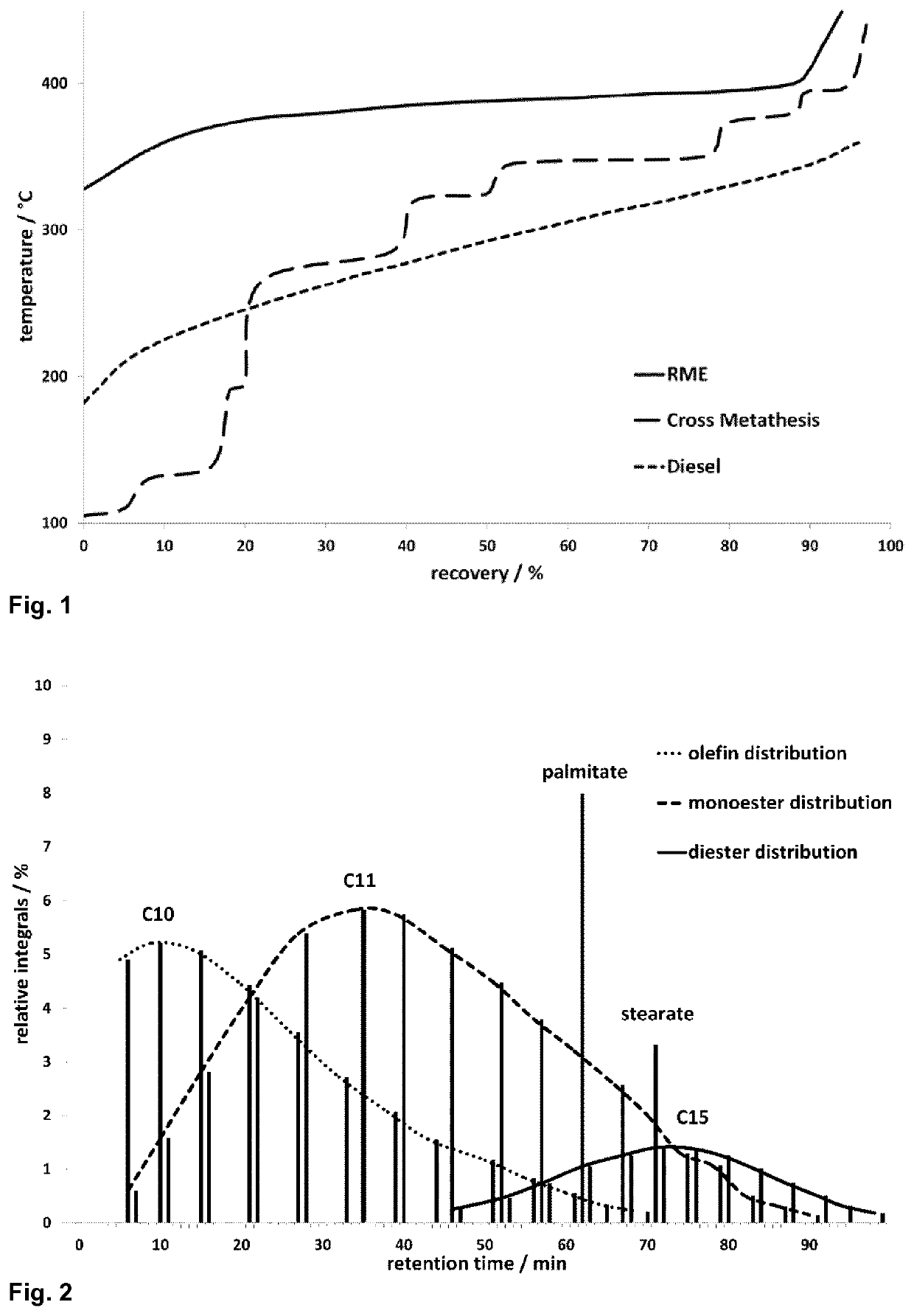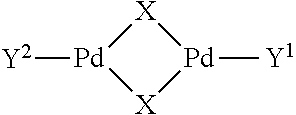Biofuel and method for preparation by isomerizing metathesis
a biofuel and metathesis technology, applied in the direction of hydrocarbon preparation catalysts, organic compounds/hydrides/coordination complexes, physical/chemical process catalysts, etc., can solve the problems of affecting the ignition behaviour of biodiesel, the unfavourable boiling behaviour remains a major challenge, and the use of biodiesel in larger percentages or in pure form is problematic, etc., to achieve low cost, low cost, and optimal fuel ignition and combustion
- Summary
- Abstract
- Description
- Claims
- Application Information
AI Technical Summary
Benefits of technology
Problems solved by technology
Method used
Image
Examples
example 1
l Reaction
[0122]Step 1: Ethenolysis of RME
[0123]Under an atmosphere of argon, a 1 L stirred Parr autoclave was charged with HGI catalyst (Hoveyda Grubbs I; 3.60 g, 600 μmol) and rape seed oil methyl ester (178 g, 200 mL, 600 mmol based on methyl oleate). The vessel was pressurized with 10 bar ethylene and stirred for 16 h at 25° C. The reactor was cooled down to −20° C. and the ethylene pressure was slowly released. After warming up to ambient temperature, the reaction mixture was filtered over silica and distilled under vacuum (1×10−3 mbar, up to 250° C.) yielding a mixture of 1-decene and methyl decenoate:methyl oleate:dimethyl octadec-9-enedionate with the ratio 82.7:10.0:5.00 as well as small amounts of additional olefins and saturated components of RME. Due to the reaction being equilibrium, complete conversion could not be achieved. Under the above mentioned solvent-free conditions the excess of ethylene in solution is too small to shift the equilibrium completely to the side ...
example 2
ep Reaction Upscale
[0126]In a glovebox under nitrogen atmosphere, a 1 L Parr autoclave was charged with Ru-CAAC catalyst [CAS: 959712-80-2] (243 mg, 0.40 mmol), IC-1 (1.24 g, 1.60 mmol), M73SIPr catalyst (330 mg, 0.40 mmol) and RME (135 mL, 400 mmol based on methyl oleate). The resulting reaction mixture was put under a stream of ethylene at atmosphere pressure and was stirred for 16 h at 60° C. The reactor was cooled down to ambient temperature and a 30% solution of H2O2 (40.9 mL, 400 mmol) was slowly added at 0° C. under vigorous stirring. The organic phase was separated, dried over MgSO4 and filtered over a short column of celite and MgSO4, yielding 75 mL of a brown oil (55% based on volume). The total yield could be increased to 75% or higher if further product was recovered from the aqueous phase. After distillation in vacuum (1E-3 mbar, >350° C.), the product mixture was obtained as a light yellow liquid (>98 wt-% recovery after distillation). The composition was analyzed by g...
example 3
ep Reaction with Optimized Yield
[0127]In a glovebox under nitrogen atmosphere, a 30 mL glass reactor was charged with Ru-CAAC catalyst [CAS: 959712-80-2] (30.3 mg, 50.0 μmol), IC-1 (155 mg, 200 μmol), M73SIPr catalyst (41.3 mg, 50.0 μmol) and RME (16.9 mL, 50 mmol based on methyl oleate). The resulting reaction mixture was put under a stream of ethylene at atmosphere pressure and was stirred for 16 h at 60° C. Two of these batches were combined, cooled down to ambient temperature and a 30% solution of H2O2 (5.11 mL, 50 mmol) was slowly added at 0° C. under vigorous stirring. The organic phase was separated, dried over MgSO4 and filtered over a short column of celite and MgSO4, yielding 25 mL of a brown oil (74% based on volume). After distillation in vacuum (1E-3 mbar, >350° C.), 24 mL of the product mixture was obtained as a light yellow liquid (96% recovery after distillation).
PUM
| Property | Measurement | Unit |
|---|---|---|
| pressure | aaaaa | aaaaa |
| boiling point | aaaaa | aaaaa |
| boiling point | aaaaa | aaaaa |
Abstract
Description
Claims
Application Information
 Login to View More
Login to View More - R&D
- Intellectual Property
- Life Sciences
- Materials
- Tech Scout
- Unparalleled Data Quality
- Higher Quality Content
- 60% Fewer Hallucinations
Browse by: Latest US Patents, China's latest patents, Technical Efficacy Thesaurus, Application Domain, Technology Topic, Popular Technical Reports.
© 2025 PatSnap. All rights reserved.Legal|Privacy policy|Modern Slavery Act Transparency Statement|Sitemap|About US| Contact US: help@patsnap.com



